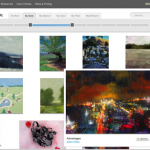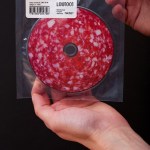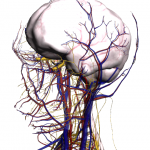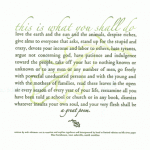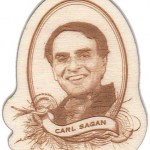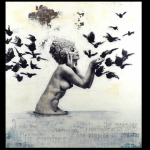ephemera
TurningArt is a startup that lets you make a queue of prints by various independent artists, try the prints out in your home or office, and exchange them as often as you like. After you've lived with the print long enough, you can trade it in for the original canvas, watercolor or collage; you just pay the balance of the original's cost (and your subscription fees count as credit toward the purchase price).
Check out how it works, below the fold. . .
Easy, right? (As an artist, my anxieties are greatly allayed by the fact that they're shipping prints around in those tubes, not the…
The NYT has a great little article about Chevalier Jackson, a turn-of-the-century doctor who kept a collection of foreign objects removed from people's throats. Dr. Jackson
"preserved more than 2,000 objects that people had swallowed or inhaled: nails and bolts, miniature binoculars, a radiator key, a child's perfect-attendance pin, a medallion that says "Carry me for good luck." . . . He was so intent on assembling his collection that he once refused to return a swallowed quarter, even when its owner threatened his life."
On February 18, the Mutter Museum, which owns Jackson's collection,…
Well, this is certainly ephemera: a Norwegian musician made instruments out of ice and then played them. Sounds like a lot of very cold work to me.
PS: The msnbc clip I initially found suffers on embedding from A) a stupid preliminary ad, B) high volume on the stupid ad, and C) practically no volume at all on the, ahem, musical clip that is supposed to be the focus of attention. Pathetic, msnbc. I retaliated by replacing it with an itnnews clip from YouTube that has none of those problems. Click through to see the msnbc clip if you'd like more ice music.
Unfortunately, the shift to digital music sales has largely eliminated the art of traditional album design - framing the music in cleverly designed sleeves and cases. The new Shidlas cd, "Saliami Postmodern," is a meaty exception. Yum:
Via Fubiz (the weirdest thing about the fubiz post is when they show the cd in a Discman. Who still has those?)
Design by Mother Eleganza.
This series of sciart wallpapers by Dan Funderburgh were inspired by the Time-Life Science Library, a series of educational books published in the 1960s. For those of us old enough to remember them, Time-Life's series are objects of nostalgia in themselves. Coupling the vintage design and palettes of those books with vintage sci-art symbolism yields a sharply contemporary set of prints.
Funderburgh describes his work as "a repudiation of the fabricated schism between art and decoration;" you could also describe it as a repudiation of the fabricated gulf between science and design. (Fun…
Fabrication de bonbons à Berlin from philmotion productions on Vimeo.
Via NOTCOT.
No. "If we could gather all the electric eels from all around the world," they would free their imprisoned brother from his Yuletide servitude and bio-tase the crap out of you, bro.
Just sayin'.
Via iO9, a Nature News slideshow of natural history engravings by physician Martin Lister's teenage daughters, who contributed technically accurate engravings of shells to one of his books, the Historiae Conchyliorum:
Historians now believe the pair were the first women to use microscopes to help produce some of their scientific drawings. Anna and Susanna's place in the history of science is explored in a biography of Martin Lister in preparation by historian Anna Marie Roos of the University of Oxford's Cultures of Knowledge project. In a recent web post, Roos describes how she stumbled…
Because people have been discussing Google ngrams a lot, and because there are always major caveats to new datamining methodologies, I have to link Natalie Binder's excellent series of posts urging caution, not only about the methodology, but about assuming too much about ngrams' utility in social research.
Binder says,
The value of the Ngrams Viewer rests on a bold conceit: that the number of times a word is used at certain periods of time has some kind of relationship to the culture of the time. For example, the fact that the word "slavery" peaks around 1860 suggests that people in 1860…
The ultimate bioephemera: art you eat! This cephalopod by specialty cake artist Karen Portoleo is definitely NOT a cake wreck (although if there were a little cake(ship)wreck under those tentacles, it might not be a bad addition). Karen previously made a "gingerbread" house with an octopus icing and tiling the roof. For serious.
Thanks to Patricia for the link! (Check out Patricia's art blog, too).
National Museum of Health & Medicine has an amazing flickrstream of vintage medical photographs and other ephemera. Lately they've been adding diagnostic/documentary photos of Civil War soldiers, as well as some military propaganda posters (anti-VD and anti-food waste, of all things). This series of photos of a lab setup for measuring cranial capacity are my favorites. Check out the handled basket of skulls! And they're using an "insufflator!" I did not even know that was a word.
Happy holidays to our friends at Bottled Monsters and thanks for all the wonderful photos!
Water + physics = beautiful work by Shinichi Maruyama.
Via Neatorama - thanks to Rhett for the tip.
Google Labs just released a new "experiment" - Body Browser. You have to upgrade to Google Chrome beta if you don't already have it, but when you do, you can play with a 3-D, rotatable reconstruction of a (female) human body. Sliders let you fade the circulatory, skeletal, muscular, and nervous systems in and out over the body organs; you can toggle labels on and off, and you can zoom, spin, and rotate in a way that would only be cooler if it were on a touchscreen iPad. (Yeah, that's what I said, Google. Do it!) Check out this screenshot:
Toggle a few sliders and you can wrap the vessels and…
Euw! Ed Yong has a gross-yet-cool post about parasitic nematodes that infect and kill caterpillars - and bring along luminous bacteria whose red glow is unpalatable to birds. If a bird eats the caterpillar host, the parasitic worms die. But the bacterial warning glow protects the worms' immobilized corpse home until they mature and burst out of the dead caterpillar - as grossly as possible, of course. (See photo on Ed's blog).
Natural, uber-gross bioephemera! Thanks, Ed. :)
This is un freaking real.
My friend John O at Armed With Science has dug up a classic animated film produced for the National Naval Medical Center in 1973. It starts with an awards ceremony for the "Communicable Disease of the Year," hosted by the Grim Reaper (who turns out to know a lot about medical history.)
The top prize is won by the Dracula-esque Count Spirochete (AKA syphilis), over the vociferous objections of a shortlist of other diseases, including smallpox ("I've scarred and disfigured millions of people!") and gonorrhea (who resembles a lavender Tribble with a pitchfork). The…
"This is what you shall do: Love the earth and sun and the animals, despise riches, give alms to every one that asks, stand up for the stupid and crazy, devote your income and labor to others, hate tyrants, argue not concerning God, have patience and indulgence toward the people, take off your hat to nothing known or unknown or to any man or number of men, go freely with powerful uneducated persons and with the young and with the mothers of families, read these leaves in the open air every season of every year of your life, re-examine all you have been told at school or church or in any book…
APOD got some attention yesterday with this stunning photo of a supercell thunderstorm several kilometers wide, brooding over a Montana field:
Mothership
Sean Heavey, 2010
I'm not sure it's possible for a work of art or photography to more effectively convey the grandeur of nature and the awesome power of physics. The image is simply unreal (which is why the title "Mothership" works so well). But Montana photographer Sean Heavey has a whole gallery of these stunning storm photos.
I'm especially nuts about the ominous, Tesla-esque drama of "Base Reflectivity":
And for all you would-be storm-…
Dave Hone's blog, Archosaur Musings, is hosting a wonderful series of interviews with paleoartists - artists and illustrators who specialize in resurrecting lost species for scientific publications, popular media, and/or fine art. Check out Mark Witton and Todd Marshall for particularly interesting perspectives.
Not only are these pretty posts with lots of eye candy, they're also excellent windows into that varied career options for anyone considering freelance medical or biological illustration. Kudos to Dave Hone for this truly useful (and I'm sure very time-consuming) series of sciart…
I've been dithering about buying these for my scientist friends, but it looks like eavesmade's etsy shop may be running low, so I'm going to quit dithering and just post this for your pre-Cyber Monday enjoyment. They're wooden scientist holiday ornaments, featuring the likes of Carl Sagan, Rosalind Franklin, and Stephen Hawking. I think they're both great and hilariously awkward.
You get six for $30 plus shipping. Order fast. . . . !
PS Thanks to Joanna for the link!
David Hochbaum
Genisis
NYC artist David Hochbaum, the creator of beguiling ephemera-inspired art, is a long-time favorite of BioE (and our friends at Phantasmaphile). Check out his Open Call portfolio, and if you will, take a moment to rate it five stars - you could help him win an artists' residency!
(psst, cephalopodphiles: this is the artist behind Mother, a piece I blogged about way back in 2007.)
